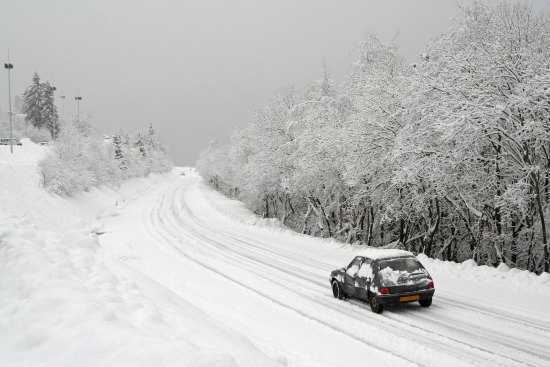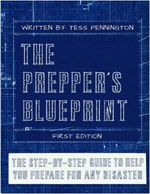This article was originally published by Jeremiah Johnson at Tess Pennington’s ReadyNutrition.com
Tess is the author of The Prepper’s Blueprint: How To Survive ANY Disaster

Whiteout conditions can be dangerous if not deadly. With cold weather around the corner, we’re going to cover some basic information on what you need to do when driving in these winter conditions.
For those of you who are unaware of what it is like driving in whiteout conditions, this is a good video that demonstrates just how dangerous it can be.
The most basic rule to follow for your safety before we proceed:
If you do not think you can drive further, pull off to the safest available portion of the shoulder or off the road, hunker down, and wait out the storm. Make sure you have some emergency supplies to survive being stranded in your vehicle.
One of the best things about living in the area that I do is that open stretches of empty road are just that: hardly any traffic at all. This Whiteout caught a lot of people off guard, and they were forced into it to make it home from work (as it began about 4 pm and lasted a few hours). Whiteouts are caused when the snowfall’s effects are exacerbated and strengthened by a strong wind. It is not necessarily a “blizzard,” but the more snowfall the worse it will be when the winds pick up. You cannot see even half a vehicle length in front of you.
How To Drive in a Whiteout
These techniques mentioned here should be practiced before you employ them for real. How do you practice? Find a road that does not have a lot of traffic that is close to your home and take one or two people with you. Take flashlights and attachments that make the flashlight a “colored cone,” preferably red as it stands out in the falling snow the best. Now practice the techniques that we will outline, with one person in the vehicle, and another one as a “control” person to help ensure success by guiding the vehicle from the outside.
Now, let’s begin. This technique can be very dangerous if you do not employ it correctly. For naysayers and law-and-order worshipers, keep in mind: there are such things as mitigating circumstances. If you’re suffering from some kind of injury with no telephone and it’s a life-or-death situation, forget about Officer (Un)Friendly and go for the win…succeed in your travel.
One of the problems with Whiteouts is with the headlights themselves. The lights reflect off the snowflakes and blind the driver. High-beams are out. Low-beams can also be “out,” and now for the punch line: You can drive through a Whiteout in a controlled manner better without the headlights than with them.
I can see smirks and skeptics gathering the straw now, but before you burn me, hear me out. Try this under normal snowfall conditions. Try it in your neighborhood, or in your driveway…if you are away from the “city glow” at night. Turn off the headlights and look around. You see? You can see. There is enough ambient light in a snowfall to allow you to see…if you follow the key rule:
You must give your eyes time to adjust to the low levels of light.
This takes practice. In the Whiteout, you’ll be able to see the outline of things without the headlights to reflect back into your eyes. You’ll see the edges of the road, and the road in the distance…farther than with the headlights. I’m not talking about with NVG’s (Night Vision Goggles). I’m talking about killing your headlights, giving your eyes time to adjust to the darkness, and then setting out slowly, at a pace where you’re sure you can drive.
If you can’t do it, then pull over to the side of the road and wait for a friendly officer with a badge…or for the storm to stop…the second option sure to be more productive.
You will see oncoming traffic, and from a long way off. Then just pull over to the side of the road and put on your headlights until the opposing traffic passes. Also: cars ahead of you can be seen from their taillights and possibly from their headlights. It takes time to perfect and takes practice. When I was in the Service, there were a couple of really good platoon sergeants who used to take everyone out in HMMWV’s (referred to as “Humvees,”) and we would “drive blind,” that is to say with no night vision goggles or any light. In Germany, when you’re driving cross country and off the road, it’s even more difficult: but we learned.
Practice does make perfect, and one final time, it’s not for everyone. When you’re faced with a life-threatening situation, however, and you must drive…it’s best to have something such as this for a plan. Let’s hear about your experiences with it, as it’s an important topic. JJ out!
About the Author
Jeremiah Johnson is the Nom de plume of a retired Green Beret of the United States Army Special Forces (Airborne). Mr. Johnson was a Special Forces Medic, EMT and ACLS-certified, with comprehensive training in wilderness survival, rescue, and patient-extraction. He is a Certified Master Herbalist and a graduate of the Global College of Natural Medicine of Santa Ana, CA. A graduate of the U.S. Army’s survival course of SERE school (Survival Evasion Resistance Escape), Mr. Johnson also successfully completed the Montana Master Food Preserver Course for home-canning, smoking, and dehydrating foods.
Mr. Johnson dries and tinctures a wide variety of medicinal herbs taken by wild crafting and cultivation, in addition to preserving and canning his own food. An expert in land navigation, survival, mountaineering, and parachuting as trained by the United States Army, Mr. Johnson is an ardent advocate for preparedness, self-sufficiency, and long-term disaster sustainability for families. He and his wife survived Hurricane Katrina and its aftermath. Cross-trained as a Special Forces Engineer, he is an expert in supply, logistics, transport, and long-term storage of perishable materials, having incorporated many of these techniques plus some unique innovations in his own homestead.
Mr. Johnson brings practical, tested experience firmly rooted in formal education to his writings and to our team. He and his wife live in a cabin in the mountains of Western Montana with their three cats.
Tess Pennington is the author of The Prepper’s Blueprint, a comprehensive guide that uses real-life scenarios to help you prepare for any disaster. Because a crisis rarely stops with a triggering event the aftermath can spiral, having the capacity to cripple our normal ways of life. The well-rounded, multi-layered approach outlined in the Blueprint helps you make sense of a wide array of preparedness concepts through easily digestible action items and supply lists.
Tess is also the author of the highly rated Prepper’s Cookbook, which helps you to create a plan for stocking, organizing and maintaining a proper emergency food supply and includes over 300 recipes for nutritious, delicious, life-saving meals.
Visit her website at ReadyNutrition.com for an extensive compilation of free information on preparedness, homesteading, and healthy living.










0 Comments